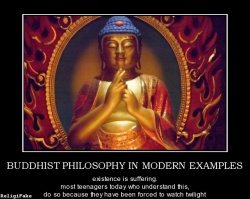Difference between revisions of "The logic of the Catuskoti"
(Created page with "<poem> ABSTRACT: In early Buddhist logic, it was standard to assume that for any state of affairs there were four possibilities: that it held, that it did not, both, or neit...") |
|||
| Line 1: | Line 1: | ||
| + | [[File:3T1.jpg|thumb|250px|]] | ||
<poem> | <poem> | ||
ABSTRACT: In early Buddhist logic, it was standard to assume that for any state of affairs there were four possibilities: that it held, that it did not, both, or neither. This is the '''catuskoti''' (or '''tetralemma'''). Classical logicians have had a hard time making sense of this, but it makes perfectly good sense in the semantics of various paraconsistent logics, such as First Degree Entailment. Matters are more complicated for later Buddhist thinkers, such as Nagarjuna, who appear to suggest that none of these options, or more than one, may hold. The point of this paper is to examine the matter, including the formal logical machinery that may be appropriate. | ABSTRACT: In early Buddhist logic, it was standard to assume that for any state of affairs there were four possibilities: that it held, that it did not, both, or neither. This is the '''catuskoti''' (or '''tetralemma'''). Classical logicians have had a hard time making sense of this, but it makes perfectly good sense in the semantics of various paraconsistent logics, such as First Degree Entailment. Matters are more complicated for later Buddhist thinkers, such as Nagarjuna, who appear to suggest that none of these options, or more than one, may hold. The point of this paper is to examine the matter, including the formal logical machinery that may be appropriate. | ||
| Line 12: | Line 13: | ||
For a start, the catuskoti, whatever it is, is something which sails very close to the wind of violating both the Principles of Excluded Middle and of Non- Contradiction. Commentators who know only so-called “classical” logic, in par- ticular, are therefore thrown into a tizzy. | For a start, the catuskoti, whatever it is, is something which sails very close to the wind of violating both the Principles of Excluded Middle and of Non- Contradiction. Commentators who know only so-called “classical” logic, in par- ticular, are therefore thrown into a tizzy. | ||
The point of this article is to make sense of the catuskoti from the enlightened position of paraconsistent logic. I shall not attempt to discuss all the historical thinkers who appealed to the catuskoti. I shall be concerned mainly with how it functioned in the thought of Nagarjuna and his Madhyamaka successors. Here, its use is, perhaps, both the most sophisticated and the most puzzling.1 | The point of this article is to make sense of the catuskoti from the enlightened position of paraconsistent logic. I shall not attempt to discuss all the historical thinkers who appealed to the catuskoti. I shall be concerned mainly with how it functioned in the thought of Nagarjuna and his Madhyamaka successors. Here, its use is, perhaps, both the most sophisticated and the most puzzling.1 | ||
| − | + | [[File:4.jpg|thumb|250px|]] | |
2 A FIRST APPROACH | 2 A FIRST APPROACH | ||
| Line 32: | Line 33: | ||
In the same way, if anyone were to say, ‘I won’t live the holy life under the Blessed One as long as he does not declare to me that ‘The cosmos is eternal,’... or that ‘After death a Tathagata neither exists nor does not exist,’ the man would die and those things would still remain undeclared by the Tathagata.... | In the same way, if anyone were to say, ‘I won’t live the holy life under the Blessed One as long as he does not declare to me that ‘The cosmos is eternal,’... or that ‘After death a Tathagata neither exists nor does not exist,’ the man would die and those things would still remain undeclared by the Tathagata.... | ||
So, Malunkyaputta, remember what is undeclared by me as undeclared, and what is declared by me as declared. And what is undeclared by me? ‘The cosmos is eternal,’ is undeclared by me. ‘The cosmos is not eternal,’ is undeclared by me. ... ‘After death a Tathagata exists’... ‘After death a Tathagata does not exist’... ‘After death a Tathagata both exists and does not exist’... ‘After death a Tathagata neither exists nor does not exist,’ is undeclared by me. | So, Malunkyaputta, remember what is undeclared by me as undeclared, and what is declared by me as declared. And what is undeclared by me? ‘The cosmos is eternal,’ is undeclared by me. ‘The cosmos is not eternal,’ is undeclared by me. ... ‘After death a Tathagata exists’... ‘After death a Tathagata does not exist’... ‘After death a Tathagata both exists and does not exist’... ‘After death a Tathagata neither exists nor does not exist,’ is undeclared by me. | ||
| + | [[File:435.jpg|thumb|250px|]] | ||
And why are they undeclared by me? Because they are not connected with the goal, are not fundamental to the holy life. They do not lead to disenchantment, dispassion, cessation, calming, direct knowledge, self-awakening, unbinding. That’s why they are undeclared by me. | And why are they undeclared by me? Because they are not connected with the goal, are not fundamental to the holy life. They do not lead to disenchantment, dispassion, cessation, calming, direct knowledge, self-awakening, unbinding. That’s why they are undeclared by me. | ||
However, in some of the sutras there is a hint of something else going on, in that the Buddha seems to explicitly reject all the options—perhaps on the ground that they have a common false presupposition. Thus, in the Mijjhima-Nikaya, the Buddha says that none of the four kotis ‘fits the case’ in such issues. When questioned how this is possible, he says (Radhakrishnan and Moore 1957, 290): | However, in some of the sutras there is a hint of something else going on, in that the Buddha seems to explicitly reject all the options—perhaps on the ground that they have a common false presupposition. Thus, in the Mijjhima-Nikaya, the Buddha says that none of the four kotis ‘fits the case’ in such issues. When questioned how this is possible, he says (Radhakrishnan and Moore 1957, 290): | ||
| Line 46: | Line 48: | ||
2.2 THE CATUSKOTI : SOME DEAD ENDS | 2.2 THE CATUSKOTI : SOME DEAD ENDS | ||
So much for the basic idea, which is clear enough. The question is how to transcribe it into the rigor of modern logic. The simple-minded thought is that for any claim, A, there are four possible cases: | So much for the basic idea, which is clear enough. The question is how to transcribe it into the rigor of modern logic. The simple-minded thought is that for any claim, A, there are four possible cases: | ||
| + | [[File:45 l.jpg|thumb|250px|]] | ||
(a) A | (a) A | ||
(b) ¬A | (b) ¬A | ||
| Line 69: | Line 72: | ||
(c) ∃x(A ∧ ¬A) | (c) ∃x(A ∧ ¬A) | ||
(d) ∃x(¬A ∧ ¬¬A) | (d) ∃x(¬A ∧ ¬¬A) | ||
| + | [[File:46cc81e.jpg|thumb|250px|]] | ||
But we still have the problem of an apparently spurious quantifier. And unless double negation fails, corners (c) and (d) collapse into each other. Even if not, case (c) entails cases (a) and (b). Moreover, Tillemans’ stated aim is to retain classical logic,1 in which case, case (c) (and case (d)) are empty. This hardly seems to do justice to matters. | But we still have the problem of an apparently spurious quantifier. And unless double negation fails, corners (c) and (d) collapse into each other. Even if not, case (c) entails cases (a) and (b). Moreover, Tillemans’ stated aim is to retain classical logic,1 in which case, case (c) (and case (d)) are empty. This hardly seems to do justice to matters. | ||
Some commentators have suggested using a non-classical logic. Thus, Staal | Some commentators have suggested using a non-classical logic. Thus, Staal | ||
| Line 91: | Line 95: | ||
applicable here, since both ¬ and × are obviously sentential. The important | applicable here, since both ¬ and × are obviously sentential. The important | ||
1 This is not quite fair to Staal. His suggestion arises in connection with the possibility of rejecting all four kotis. We then have: | 1 This is not quite fair to Staal. His suggestion arises in connection with the possibility of rejecting all four kotis. We then have: | ||
| + | [[File:48244.jpg|thumb|250px|]] | ||
(a) ¬A | (a) ¬A | ||
(b) ¬¬A | (b) ¬¬A | ||
| Line 111: | Line 116: | ||
truth value gaps and gluts; thus, from the fact that the one holds or fails follows nothing about whether the other does. We may then define four predicates as follows: | truth value gaps and gluts; thus, from the fact that the one holds or fails follows nothing about whether the other does. We may then define four predicates as follows: | ||
• T (A) is T (A) ∧ ¬F (A) | • T (A) is T (A) ∧ ¬F (A) | ||
| + | [[File:4falE3.jpg|thumb|250px|]] | ||
1 Westerhoff suggests interpreting the external negation as an illocutory negation (p. 78); that is, as the speech act of denial. (See Priest 2006b, ch. 6.) This, indeed, has a certain appeal. A problem with the approach, however, is that it makes no sense to put illocutory acts in propositional contexts. Thus, the first two of the four kotis (at least as I reformulated them) make no sense. Worse: once the possibility of denying all four kotis is on the table, the rejection | 1 Westerhoff suggests interpreting the external negation as an illocutory negation (p. 78); that is, as the speech act of denial. (See Priest 2006b, ch. 6.) This, indeed, has a certain appeal. A problem with the approach, however, is that it makes no sense to put illocutory acts in propositional contexts. Thus, the first two of the four kotis (at least as I reformulated them) make no sense. Worse: once the possibility of denying all four kotis is on the table, the rejection | ||
of the fourth koti would have to be expressed as × × (A ∨ ¬A). This makes no sense, since | of the fourth koti would have to be expressed as × × (A ∨ ¬A). This makes no sense, since | ||
| Line 132: | Line 138: | ||
care must be taken with the biconditional in question. One may be tempted to reason as follows: | care must be taken with the biconditional in question. One may be tempted to reason as follows: | ||
T (A) ↔ A T -schema | T (A) ↔ A T -schema | ||
| + | [[File:4qOL6E1qi.jpg|thumb|250px|]] | ||
¬A ↔ ¬T (A) Contraposition | ¬A ↔ ¬T (A) Contraposition | ||
T (¬A) ↔ ¬A T -schema | T (¬A) ↔ ¬A T -schema | ||
| Line 153: | Line 160: | ||
made for each other in a Buddhist heaven.2 So let us take FDE to provide the | made for each other in a Buddhist heaven.2 So let us take FDE to provide the | ||
semantics and logic of the language. | semantics and logic of the language. | ||
| + | [[File:541.jpg|thumb|250px|]] | ||
FDE can be characterised by the following rule system. (A double line indicates a two-way rule, and overlining indicates discharging an assumption.)3 | FDE can be characterised by the following rule system. (A double line indicates a two-way rule, and overlining indicates discharging an assumption.)3 | ||
A, B A ∧ B A ∧ B A (B) | A, B A ∧ B A ∧ B A (B) | ||
| Line 178: | Line 186: | ||
As for the T -schema, FDE contains no real conditional connective. To keep things simple, we can take the biconditional in the Schema to be bi-entailment. | As for the T -schema, FDE contains no real conditional connective. To keep things simple, we can take the biconditional in the Schema to be bi-entailment. | ||
That is, A ↔ B is: A I= B and B I= A.1 The truth conditions for T clearly now | That is, A ↔ B is: A I= B and B I= A.1 The truth conditions for T clearly now | ||
| + | [[File:543586.jpg|thumb|250px|]] | ||
deliver the validity of the Schema, though not its contraposed form, since we may have T (A) being t while A is b. In this case, ¬A will be b when ¬T (A) is f , so | deliver the validity of the Schema, though not its contraposed form, since we may have T (A) being t while A is b. In this case, ¬A will be b when ¬T (A) is f , so | ||
¬A ¬T (A). | ¬A ¬T (A). | ||
| Line 196: | Line 205: | ||
How can the tetralemma of finite, infinite, etc. Be true of the peaceful? | How can the tetralemma of finite, infinite, etc. Be true of the peaceful? | ||
and at MMK XXV: 17, we have:2 | and at MMK XXV: 17, we have:2 | ||
| + | [[File:5XiC1.jpg|thumb|250px|]] | ||
Having passed into nirvana, the Victorious Conqueror | Having passed into nirvana, the Victorious Conqueror | ||
Is neither said to be existent Nor said to be nonexistent. Neither both nor neither are said. | Is neither said to be existent Nor said to be nonexistent. Neither both nor neither are said. | ||
| Line 212: | Line 222: | ||
However, one should be careful about the word that is being translated as ‘view’ here. Two Sanskrit words standardly get translated in this way, drsti and darsana. The latter simply means ‘teaching’; the former means something like a doctrine about the objects of ultimate reality. The word in the passage I have just quoted is drsti : Nagarjuna thinks that everything is empty of self-being (svabhava ). There are no objects with ultimate reality in this sense. Hence, any theory of such objects is mistaken, and so should be given up. But Nagarjuna does not think that all teachings are to be given up. Indeed, the MMK and the writings of most of Nagarjuna’s Madhyamaka successors, contain many positive teachings: that everything, including emptiness, is empty, is one such. Thus, MMK XXIV: 18 tells us, famously: | However, one should be careful about the word that is being translated as ‘view’ here. Two Sanskrit words standardly get translated in this way, drsti and darsana. The latter simply means ‘teaching’; the former means something like a doctrine about the objects of ultimate reality. The word in the passage I have just quoted is drsti : Nagarjuna thinks that everything is empty of self-being (svabhava ). There are no objects with ultimate reality in this sense. Hence, any theory of such objects is mistaken, and so should be given up. But Nagarjuna does not think that all teachings are to be given up. Indeed, the MMK and the writings of most of Nagarjuna’s Madhyamaka successors, contain many positive teachings: that everything, including emptiness, is empty, is one such. Thus, MMK XXIV: 18 tells us, famously: | ||
1 See Hayes 1994, 325 ff. | 1 See Hayes 1994, 325 ff. | ||
| + | [[File:65.jpg|thumb|250px|]] | ||
Whatever is dependently co-arisen That is explained to be emptiness. That, being a dependent designation, Is itself the middle way. | Whatever is dependently co-arisen That is explained to be emptiness. That, being a dependent designation, Is itself the middle way. | ||
You do not have to understand exactly what this means to see that a positive view about emptiness is being advocated here. It is not a mere rejection. | You do not have to understand exactly what this means to see that a positive view about emptiness is being advocated here. It is not a mere rejection. | ||
| Line 225: | Line 236: | ||
behave differently if the two are to represent distinct alternatives. The simplest suggestion is to take e to be such that whenever any input has the value e, so does the output: e-in/e-out.2 | behave differently if the two are to represent distinct alternatives. The simplest suggestion is to take e to be such that whenever any input has the value e, so does the output: e-in/e-out.2 | ||
The logic that results by modifying FDE in this way is obviously a sub-logic of it. It is a proper sub-logic. It is not difficult to check that all the rules of FDE are designation-preserving except the rule for disjunction-introduction, which is not, as an obvious counter-model shows. However, replace this with the rules: | The logic that results by modifying FDE in this way is obviously a sub-logic of it. It is a proper sub-logic. It is not difficult to check that all the rules of FDE are designation-preserving except the rule for disjunction-introduction, which is not, as an obvious counter-model shows. However, replace this with the rules: | ||
| + | [[File:6602.jpg|thumb|250px|]] | ||
ϕ(A) C A ∨ C | ϕ(A) C A ∨ C | ||
�ϕ(A) C | �ϕ(A) C | ||
| Line 250: | Line 262: | ||
Moreover, so is every instance of E2. The arguments for the old cases are much the same as before (though we need to bear in mind that the N has been redefined). The four new cases are: | Moreover, so is every instance of E2. The arguments for the old cases are much the same as before (though we need to bear in mind that the N has been redefined). The four new cases are: | ||
• ¬(T (A) ∧ E (A)) | • ¬(T (A) ∧ E (A)) | ||
| + | [[File:681x454.jpg|thumb|250px|]] | ||
• ¬(F (A) ∧ E (A)) | • ¬(F (A) ∧ E (A)) | ||
• ¬(B (A) ∧ E (A)) | • ¬(B (A) ∧ E (A)) | ||
| Line 268: | Line 281: | ||
(3) Unrelinquished, unattained, Unannihilated, not permanent, Unarisen, unceased: | (3) Unrelinquished, unattained, Unannihilated, not permanent, Unarisen, unceased: | ||
This is how nirvana is described. | This is how nirvana is described. | ||
| + | [[File:6828.jpg|thumb|250px|]] | ||
There then follow the arguments for this, based on the four kotis. (Each of the cases has a number of different reasons. I quote only one for each.) | There then follow the arguments for this, based on the four kotis. (Each of the cases has a number of different reasons. I quote only one for each.) | ||
(5) If nirvana were existent, Nirvana would be compounded A non-compounded existent Does not exist anywhere | (5) If nirvana were existent, Nirvana would be compounded A non-compounded existent Does not exist anywhere | ||
| Line 286: | Line 300: | ||
Much more plausible, it would seem, is this. When we get a statement of the fourfold negation, it is not a categorical assertion. Rather, it is a consequence of the assumption that something has svabhava. Since these are the only four cases, we apply a perfectly standard reductio, and conclude that the thing in question does not have svabhava. | Much more plausible, it would seem, is this. When we get a statement of the fourfold negation, it is not a categorical assertion. Rather, it is a consequence of the assumption that something has svabhava. Since these are the only four cases, we apply a perfectly standard reductio, and conclude that the thing in question does not have svabhava. | ||
While we are on the subject of reductio, and since we are taking advantage of a paraconsistent logic—indeed, the possibility of dialetheism—let me add an extra word about this. Some commentators have argued that Nagarjuna subscribed to the Principle of Non-Contradiction. Thus, for example, Robinson endorses this view. In support of it, he quotes MMK VII: 30 and VIII: 7.1 These passages occur in the midst of rejecting one of the kotis of the catuskoti for the subject being discussed (conditioned objects, and agents/actions, respectively), and read, respectively: | While we are on the subject of reductio, and since we are taking advantage of a paraconsistent logic—indeed, the possibility of dialetheism—let me add an extra word about this. Some commentators have argued that Nagarjuna subscribed to the Principle of Non-Contradiction. Thus, for example, Robinson endorses this view. In support of it, he quotes MMK VII: 30 and VIII: 7.1 These passages occur in the midst of rejecting one of the kotis of the catuskoti for the subject being discussed (conditioned objects, and agents/actions, respectively), and read, respectively: | ||
| + | [[File:6Oq2RZVl.jpg|thumb|250px|]] | ||
Moreover, for an existent thing | Moreover, for an existent thing | ||
Cessation is not tenable. | Cessation is not tenable. | ||
| Line 301: | Line 316: | ||
that I am a frog—which should certainly be rejected. But that the liar sentence is both true and not true is not clearly absurd. Contemporary dialetheists about the semantic paradoxes hold it to be true. Many simple claims, such as that I am a frog, are much more absurd than this.1 | that I am a frog—which should certainly be rejected. But that the liar sentence is both true and not true is not clearly absurd. Contemporary dialetheists about the semantic paradoxes hold it to be true. Many simple claims, such as that I am a frog, are much more absurd than this.1 | ||
The second point concerns the following question. We have been talking about acceptability—but acceptability to whom? The MMK is a highly polemical work. Though he never cites them, Nagarjuna clearly has certain opponents in his sights. These were, presumably, denizens of the other schools of Indian thought, both Buddhist and non-Buddhist, who were active in this turbulent intellectual period. Now, in a dialectical context of that kind, for an argument to work, it is not neces- sary that Nagarjuna himself takes the conclusion in question, be it a contradiction or something else, to be unacceptable: he may or he may not. The argument will work if the opponent takes it to be so. (This is exactly how the arguments of a Pyrrhonian skeptic are supposed to get their bite.) And certainly, a number of the schools around at the time, such as the Nyaya, would have subscribed firmly to the Principle of Non-Contradiction. Hence, nothing about Nagarjuna’s own view about the possibility of something satisfying the third koti of the catuskoti can be inferred from his use of reductio arguments. | The second point concerns the following question. We have been talking about acceptability—but acceptability to whom? The MMK is a highly polemical work. Though he never cites them, Nagarjuna clearly has certain opponents in his sights. These were, presumably, denizens of the other schools of Indian thought, both Buddhist and non-Buddhist, who were active in this turbulent intellectual period. Now, in a dialectical context of that kind, for an argument to work, it is not neces- sary that Nagarjuna himself takes the conclusion in question, be it a contradiction or something else, to be unacceptable: he may or he may not. The argument will work if the opponent takes it to be so. (This is exactly how the arguments of a Pyrrhonian skeptic are supposed to get their bite.) And certainly, a number of the schools around at the time, such as the Nyaya, would have subscribed firmly to the Principle of Non-Contradiction. Hence, nothing about Nagarjuna’s own view about the possibility of something satisfying the third koti of the catuskoti can be inferred from his use of reductio arguments. | ||
| + | [[File:6yzo.jpg|thumb|250px|]] | ||
Doubtless there is more to be said about these matters. But it is time to return from the digression. | Doubtless there is more to be said about these matters. But it is time to return from the digression. | ||
| Line 320: | Line 336: | ||
of the form T (A) ∧ ¬T (A) ∧ F (A) ∧ ¬F (A). Let A have the value b. Then T (A) and F (A) are both designated. Let them take the value b. Then ¬T (A) and ¬F (A) both take the value b as well. Hence the whole conjunction takes the | of the form T (A) ∧ ¬T (A) ∧ F (A) ∧ ¬F (A). Let A have the value b. Then T (A) and F (A) are both designated. Let them take the value b. Then ¬T (A) and ¬F (A) both take the value b as well. Hence the whole conjunction takes the | ||
value b, and so is true—and false as well. Just what we need. I note, moreover, | value b, and so is true—and false as well. Just what we need. I note, moreover, | ||
| + | [[File:7-26-1.jpg|thumb|250px|]] | ||
1 See Deguchi, Garfield, and Priest 2008. | 1 See Deguchi, Garfield, and Priest 2008. | ||
2 As suggested in Garfield 1995, 250, and Garfield and Priest 2003, 13-14. | 2 As suggested in Garfield 1995, 250, and Garfield and Priest 2003, 13-14. | ||
| Line 340: | Line 357: | ||
¬, ∨, and ∧ in FDE, by f¬, f∨, and f∧, then the most obvious extension of ρ to | ¬, ∨, and ∧ in FDE, by f¬, f∨, and f∧, then the most obvious extension of ρ to | ||
all formulas is given by the clauses: | all formulas is given by the clauses: | ||
| + | [[File:7003efd.jpg|thumb|250px|]] | ||
• ¬Aρv iff for some x such that Aρx, v = f¬(x) | • ¬Aρv iff for some x such that Aρx, v = f¬(x) | ||
• A ∨ Bρv iff for some x, y, such that Aρx and Bρy, v = f∨(x, y) | • A ∨ Bρv iff for some x, y, such that Aρx and Bρy, v = f∨(x, y) | ||
| Line 362: | Line 380: | ||
of F, the second is just a special case of the first.) Then the sentence will be equivalent to a disjunction which has a part of the form T (A) ∨ ¬T (A). A | of F, the second is just a special case of the first.) Then the sentence will be equivalent to a disjunction which has a part of the form T (A) ∨ ¬T (A). A | ||
relates to at least one value. If this is designated, the first disjunct relates to a designated value; if it is not, the second one does. Hence, the disjunction relates to a designated value. | relates to at least one value. If this is designated, the first disjunct relates to a designated value; if it is not, the second one does. Hence, the disjunction relates to a designated value. | ||
| + | [[File:7t1qa5.jpg|thumb|250px|]] | ||
Notwithstanding this, a sentence stating that A has more that one koti can also be true. Thus, suppose that on some evaluation A relates to t, b, and n. Consider | Notwithstanding this, a sentence stating that A has more that one koti can also be true. Thus, suppose that on some evaluation A relates to t, b, and n. Consider | ||
T (A) ∧ B (A) ∧ N (A). Each conjunct relates to a designated value. Hence the | T (A) ∧ B (A) ∧ N (A). Each conjunct relates to a designated value. Hence the | ||
| Line 379: | Line 398: | ||
• (Aρf or Aρn or for no v, Aρv) iff T (A) ρf | • (Aρf or Aρn or for no v, Aρv) iff T (A) ρf | ||
For E: | For E: | ||
| + | [[File:7t1qa5.jpg|thumb|250px|]] | ||
• (Aρt or Aρf or Aρb or Aρn) iff E (A) ρf of E (A) ρb | • (Aρt or Aρf or Aρb or Aρn) iff E (A) ρf of E (A) ρb | ||
• for no ν, Aρv iff E (A) ρt | • for no ν, Aρv iff E (A) ρt | ||
| Line 395: | Line 415: | ||
often say that there are no ultimate truths, but then go on to enunciate some | often say that there are no ultimate truths, but then go on to enunciate some | ||
of them!—that there are no ultimate truths being a most important one such.1 | of them!—that there are no ultimate truths being a most important one such.1 | ||
| + | [[File:920.jpg|thumb|250px|]] | ||
This suggests that we may indeed have things of the form Tu (A) ∧ Nu (A), or | This suggests that we may indeed have things of the form Tu (A) ∧ Nu (A), or | ||
Bu (A) ∧ Eu (A). As we have seen, our constructions accommodate this possibility. | Bu (A) ∧ Eu (A). As we have seen, our constructions accommodate this possibility. | ||
| Line 410: | Line 431: | ||
3 The strategy does not, note, avoid the apparent contradiction concerning the claim that there are no ultimate truths, since we still have that for no A, REALLY(A), and where this is itself C , REALLY(C ). | 3 The strategy does not, note, avoid the apparent contradiction concerning the claim that there are no ultimate truths, since we still have that for no A, REALLY(A), and where this is itself C , REALLY(C ). | ||
Which, if any, of these strategies is most appropriate, depends on doctrinal matters that are beyond the scope of this essay. The discussion, at least, serves to illustrate how doctrinal issues may feed into the deployment of the technical machinery developed here. We have already, of course, seen an example of the converse: if the four values of the catuskoti are not exhaustive, this will undercut Nagarjuna’s deployment of it in the Mulamadhyamakakarika, and so have doc- trinal implications. Again, it is not appropriate to take up this issue here. It is enough that the paper has provided technical tools which interact with doctrinal issues in important ways. | Which, if any, of these strategies is most appropriate, depends on doctrinal matters that are beyond the scope of this essay. The discussion, at least, serves to illustrate how doctrinal issues may feed into the deployment of the technical machinery developed here. We have already, of course, seen an example of the converse: if the four values of the catuskoti are not exhaustive, this will undercut Nagarjuna’s deployment of it in the Mulamadhyamakakarika, and so have doc- trinal implications. Again, it is not appropriate to take up this issue here. It is enough that the paper has provided technical tools which interact with doctrinal issues in important ways. | ||
| − | + | [[File:A.jpg|thumb|250px|]] | |
6 CONCLUSION | 6 CONCLUSION | ||
The catuskoti and its ramifications are a central part of logic in both the original and the later Madhyamaka Buddhist traditions.1 How to understand it has, as we have seen, been a deeply puzzling matter for most Western commentators, trained, as they are, only in traditional (Aristotelian) or classical (Frege-Russell) logic. We have seen how the tools of non-classical logic, and particularly of some paraconsistent logics, can be used to explicate the ideas involved in a precise and rigorous fashion. | The catuskoti and its ramifications are a central part of logic in both the original and the later Madhyamaka Buddhist traditions.1 How to understand it has, as we have seen, been a deeply puzzling matter for most Western commentators, trained, as they are, only in traditional (Aristotelian) or classical (Frege-Russell) logic. We have seen how the tools of non-classical logic, and particularly of some paraconsistent logics, can be used to explicate the ideas involved in a precise and rigorous fashion. | ||
| Line 431: | Line 452: | ||
model we read off the values of T (A) from the above regime, and establish that | model we read off the values of T (A) from the above regime, and establish that | ||
the definition delivers the semantic conditions for T as follows. | the definition delivers the semantic conditions for T as follows. | ||
| + | [[File:Alms thai.jpg|thumb|250px|]] | ||
• If ν(A) ∈ D, then A ∈ ∆. By the T rules, T (A) ∈ ∆, and so ν(T (A)) ∈ D. | • If ν(A) ∈ D, then A ∈ ∆. By the T rules, T (A) ∈ ∆, and so ν(T (A)) ∈ D. | ||
• If ν(A) ∈/ D then A ∈/ ∆ and so T (A) ∈/ ∆. By the T rules and primeness, | • If ν(A) ∈/ D then A ∈/ ∆ and so T (A) ∈/ ∆. By the T rules and primeness, | ||
| Line 451: | Line 473: | ||
ϕ Rules, which is impossible. | ϕ Rules, which is impossible. | ||
And for conjunction: | And for conjunction: | ||
| + | [[File:Almsbowl2.jpg|thumb|250px|]] | ||
• ν(A) = n and ν(B) = n. Then A, ¬A, B, ¬B ∈/ | • ν(A) = n and ν(B) = n. Then A, ¬A, B, ¬B ∈/ | ||
∆ and for some C , D, | ∆ and for some C , D, | ||
| Line 475: | Line 498: | ||
• If ν(A) /= e then for some ϕ, ϕ(A) ∈ ∆ . Hence ¬E (A) ∈ ∆ (by the ϕ | • If ν(A) /= e then for some ϕ, ϕ(A) ∈ ∆ . Hence ¬E (A) ∈ ∆ (by the ϕ | ||
rules); so E (A) has the value f or b. | rules); so E (A) has the value f or b. | ||
| − | + | [[File:AMip1.jpg|thumb|250px|]] | |
7.3 FDE AND FDES: RELATIONAL SEMANTICS | 7.3 FDE AND FDES: RELATIONAL SEMANTICS | ||
Next we turn to the relational semantics with the Exhaustivity condition, Exh. FDE is sound and complete with respect to these. To show soundness, we establish that all the rules preserve the property of relating to some designated value. This is straightforward. To prove completeness, we use the canonical model construction. A prime deductively closed theory is constructed in the usual way. We then read off an evaluation as follows: | Next we turn to the relational semantics with the Exhaustivity condition, Exh. FDE is sound and complete with respect to these. To show soundness, we establish that all the rules preserve the property of relating to some designated value. This is straightforward. To prove completeness, we use the canonical model construction. A prime deductively closed theory is constructed in the usual way. We then read off an evaluation as follows: | ||
| Line 498: | Line 521: | ||
¬T (A) ∈ ∆. Hence, T (A) relates to f. | ¬T (A) ∈ ∆. Hence, T (A) relates to f. | ||
• Conversely, if T (A) relates to f , then T (A) ∈/ ∆, so A ∈/ ∆. So A relates to f or n. | • Conversely, if T (A) relates to f , then T (A) ∈/ ∆, so A ∈/ ∆. So A relates to f or n. | ||
| − | + | [[File:AMip1l.jpg|thumb|250px|]] | |
7.4 FDEϕ AND FDEϕS: RELATIONAL SEMANTICS | 7.4 FDEϕ AND FDEϕS: RELATIONAL SEMANTICS | ||
| Line 523: | Line 546: | ||
ACKNOWLEDGEMENTS | ACKNOWLEDGEMENTS | ||
| − | + | [[File:Amitabha.JPG|thumb|250px|]] | |
Versions of this paper were given at the University of St Andrews and at the conference Modern Formalisms for Pre-Modern Indian Logic and Epistemology, University of Hamburg, June 2010. Many thanks go to the audiences there for their comments, and especially to Josh Dever and Stephen Read. Thanks for written comments also go to Jay Garfield, Bo Mou, Richard Tieszen, and some anonymous referees. | Versions of this paper were given at the University of St Andrews and at the conference Modern Formalisms for Pre-Modern Indian Logic and Epistemology, University of Hamburg, June 2010. Many thanks go to the audiences there for their comments, and especially to Josh Dever and Stephen Read. Thanks for written comments also go to Jay Garfield, Bo Mou, Richard Tieszen, and some anonymous referees. | ||
| Line 566: | Line 589: | ||
</poem> | </poem> | ||
{{R}} | {{R}} | ||
| − | |||
| − | |||
[[Category:Buddhist Logic]] | [[Category:Buddhist Logic]] | ||
Revision as of 07:40, 8 January 2013
ABSTRACT: In early Buddhist logic, it was standard to assume that for any state of affairs there were four possibilities: that it held, that it did not, both, or neither. This is the catuskoti (or tetralemma). Classical logicians have had a hard time making sense of this, but it makes perfectly good sense in the semantics of various paraconsistent logics, such as First Degree Entailment. Matters are more complicated for later Buddhist thinkers, such as Nagarjuna, who appear to suggest that none of these options, or more than one, may hold. The point of this paper is to examine the matter, including the formal logical machinery that may be appropriate.
Keywords: catuskoti, tetralemma, Buddhist logic, unanswerable questions, Nagar- juna, Mulamadhyamakakarika, truth predicate, paraconsistency, First Degree Entail- ment, many-valued logic, relational semantics
1 INTRODUCTION: ENTER THE CATUSKOTI
The catuskoti 1 is a venerable principle in Buddhist logic. How it was deployed seems to have varied somewhat over the thousand-plus years of Indian Buddhism. However, it was clearly a contentious principle in the context of Indian logic. It is equally contentious to modern commentators, though the contention here is largely in how to understand it2—including how to interpret it in terms of modern logic. As one modern commentator puts it (Tillemans 1999, 189):
Within Buddhist thought, the structure of argumentation that seems most resistant to our attempts at a formalization is undoubtedly the catuskoti or tetralemma.
PRIEST, GRAHAM: Boyce Gibson Professor of Philosophy, University of Melbourne; Distinguished Professor of Philosophy, Graduate Center, City University of New York; Arch Professorial Fellow, University of At. Andrews. Email: g.priest@unimelb.edu.au
1 Actually, catu skoti, but I ignore the diacriticals in writing Sanskrit words, except in the ·
bibliography.
2 For a review, see Ruegg 1977, 39 ff.
For a start, the catuskoti, whatever it is, is something which sails very close to the wind of violating both the Principles of Excluded Middle and of Non- Contradiction. Commentators who know only so-called “classical” logic, in par- ticular, are therefore thrown into a tizzy.
The point of this article is to make sense of the catuskoti from the enlightened position of paraconsistent logic. I shall not attempt to discuss all the historical thinkers who appealed to the catuskoti. I shall be concerned mainly with how it functioned in the thought of Nagarjuna and his Madhyamaka successors. Here, its use is, perhaps, both the most sophisticated and the most puzzling.1
2 A FIRST APPROACH
2.1 BACK TO THE BEGINNING
But let us start at the beginning. In the West, the catuskoti is often called by its Greek equivalent, the tetralemma, meaning ‘four-corners’. The four corners are four options that one might take on some question: given any question, there are four possibilities, yes, no, both, and neither.
Who first formulated this thought seems to be lost in the mists of time, but it seems to be fairly orthodox in the intellectual circles of Gotama, the historical Buddha (c. 6c BCE). Thus, canonical Buddhist texts often set up issues in terms of these four possibilities. For example, in the Mijjhima-Nikaya, when the Buddha is asked about one of the profound metaphysical issues, the text reads as follows:2
‘How is it, Gotama? Does Gotama believe that the saint exists after death, and that this view alone is true, and every other false?’
‘Nay, Vacca. I do not hold that the saint exists after death, and that this view alone is true, and every other false.’
‘How is it, Gotama? Does Gotama believe that the saint does not exist after death, and that this view alone is true, and every other false?’
‘Nay, Vacca. I do not hold that the saint does not exist after death, and that this view alone is true, and every other false.’
‘How is it, Gotama? Does Gotama believe that the saint both exists and does not exist after death, and that this view alone is true, and every other false?’
‘Nay, Vacca. I do not hold that the saint both exists and does not exist after death, and that this view alone is true, and every other false.’
‘How is it, Gotama? Does Gotama believe that the saint neither exists nor does not exist after death, and that this view alone is true, and every other false?’
‘Nay, Vacca. I do not hold that the saint neither exists nor does not exist after death, and that this view alone is true, and every other false.’
1 As Tillemans 1999, 189, notes.
2 Radhakrishnan and Moore 1957, 289 f. The word ‘saint’ is a rather poor translation. It refers to someone who has attained enlightenment, a Buddha (Tathagata).
It seems clear from the dialogue that the Buddha’s interlocutor thinks of him- self as offering an exclusive and exhaustive disjunction from which to choose. True, the Buddha never endorses any of the positions offered—on this and other similar “unanswerable” questions. But a rationale commonly offered for this is that these matters are of no soteriological importance; they are just a waste of time.1 Thus, in the Cula-Malunkyovada Sutta, we read (Thanissaro 1998):
It’s just as if a man were wounded with an arrow thickly smeared with poison. His friends and companions, kinsmen and relatives would provide him with a surgeon, and the man would say, ‘I won’t have this arrow removed until I know whether the man who wounded me was a noble warrior, a priest, a merchant, or a worker.’ He would say, ‘I won’t have this arrow removed until I know the given name and clan name of the man who wounded me... until I know whether he was tall, medium, or short... until I know whether he was dark, ruddy-brown, or golden-colored... until I know his home village, town, or city... .’ The man would die and those things would still remain unknown to him.
In the same way, if anyone were to say, ‘I won’t live the holy life under the Blessed One as long as he does not declare to me that ‘The cosmos is eternal,’... or that ‘After death a Tathagata neither exists nor does not exist,’ the man would die and those things would still remain undeclared by the Tathagata....
So, Malunkyaputta, remember what is undeclared by me as undeclared, and what is declared by me as declared. And what is undeclared by me? ‘The cosmos is eternal,’ is undeclared by me. ‘The cosmos is not eternal,’ is undeclared by me. ... ‘After death a Tathagata exists’... ‘After death a Tathagata does not exist’... ‘After death a Tathagata both exists and does not exist’... ‘After death a Tathagata neither exists nor does not exist,’ is undeclared by me.
And why are they undeclared by me? Because they are not connected with the goal, are not fundamental to the holy life. They do not lead to disenchantment, dispassion, cessation, calming, direct knowledge, self-awakening, unbinding. That’s why they are undeclared by me.
However, in some of the sutras there is a hint of something else going on, in that the Buddha seems to explicitly reject all the options—perhaps on the ground that they have a common false presupposition. Thus, in the Mijjhima-Nikaya, the Buddha says that none of the four kotis ‘fits the case’ in such issues. When questioned how this is possible, he says (Radhakrishnan and Moore 1957, 290):
But Vacca, if the fire in front of you were to become extinct, would you be aware that the fire in front of you had become extinct?
Gotama, if the fire in front of me were to become extinct, I would be aware that the fire in front of me had become extinct.
But, Vacca, if someone were to ask you, ‘In which direction has the fire gone,—east, or west, or north, or south?’ what would you say O Vacca?
The question would not fit the case, Gotama. For the fire which depended on fuel of grass and wood, when all that fuel has gone, and it can get no other, being thus without nutriment, is said to be extinct.
1 See Ruegg 1977, 1-2.
Here lie the seeds of future complications. We will come to them in due course. For the moment, I just note that it appears to be the case that the orthodox view at the time was that the four options are mutually exclusive and exhaustive choices.1
The choice is stated more tersely and explicitly by later thinkers. For example, Aryadeva, Nagarjuna’s disciple, writes (Tillemans 1999,189):
Being, non-being, [both] being and non-being, neither being [nor] non-being: such is the method that the wise should always use with regard to identity and all other [theses].
And in the Mulamadhyamakakarika (hereafter, MMK) Nagarjuna frequently addresses an issue by considering these four cases. Thus, in ch. XXV, he considers nirvana. First, he considers the possibility that it exists (vv. 4-6); then that it does not exist (vv. 7-8); then that it both exists and does not exist (vv. 11-14); and finally, that it neither exists nor does not (vv. 14-15). We will come back to this passage later as well.
For the moment, all we need to note is that in the beginning the catuskoti functioned as something like a Principle of the Excluded Fifth. Aristotle held a principle of the Excluded Third: any statement must be either true or false; there is no third possibility; moreover, the two are exclusive. In a similar but more generous way, the catuskoti gives us an exhaustive and mutually exclusive set of four possibilities.
2.2 THE CATUSKOTI : SOME DEAD ENDS
So much for the basic idea, which is clear enough. The question is how to transcribe it into the rigor of modern logic. The simple-minded thought is that for any claim, A, there are four possible cases:
(a) A
(b) ¬A
(c) A ∧ ¬A
(d) ¬(A ∨ ¬A)
(c) will wave red flags to anyone wedded to the Principle of Non-Contradiction— but the texts seem pretty explicit that you might have to give this away. There are worse problems. Notably, assuming De Morgan’s laws, (d) is equivalent to (c), and so the two kotis collapse. Possibly, one might reject the Principle of Double
Negation, so that (d) would give us only ¬A∧¬¬A. But there are worse problems.
The four cases are supposed to be exclusive; yet case (c) entails both cases (a)
and (b). So the corners again collapse.
The obvious thought here is that we must understand (a) as saying that A is true and not false. Similarly, one must understand (b) as saying that A is false
and not true. Corners (a) and (b) then become: A ∧ ¬¬A and ¬A ∧ ¬A (i.e., ¬A).
Even leaving aside problems about double negation, case (c) still entails case (b).
We are no better off.
Unsurprisingly, then, modern commentators have tried to find other ways of expressing the catuskoti. Robinson (1956, 102 f.) suggests understanding the four corners as:
(a) ∀xA
(b) ∀x¬A
(c) ∃xA ∧ ∃x¬A
(d) ¬∃xA ∧ ¬∃x¬A
The artifice of using a quantifier is manifest. Claims such as ‘The Buddha exists after death’ and ‘The cosmos is infinite’ have no free variable. How, then, is a quantifier supposed to help? And why choose that particular combination of universal and particular quantifiers? Even supposing that one could smuggle a free variable into these claim somehow, case (d) entails case (b) (and absent a misbehaviour of double negation, it entails (a) as well).
Tillemans (1999, 200) enumerates the four corners, slightly more plausibly, as:
(a) ∃xA
(b) ∃x¬A
(c) ∃x(A ∧ ¬A)
(d) ∃x(¬A ∧ ¬¬A)
But we still have the problem of an apparently spurious quantifier. And unless double negation fails, corners (c) and (d) collapse into each other. Even if not, case (c) entails cases (a) and (b). Moreover, Tillemans’ stated aim is to retain classical logic,1 in which case, case (c) (and case (d)) are empty. This hardly seems to do justice to matters.
Some commentators have suggested using a non-classical logic. Thus, Staal
(1975, 47) suggests using intuitionist logic, so the corners become:
(a) A
(b) ¬A
1 See Tillemans 1999, 200.
(c) A ∧ ¬A
(d) ¬A ∧ ¬¬A
Moving to intuitionist logic at least motivates the failure of double negation. But case (c) still entails cases (a) and (b), and case (d) entails case (b). To add insult to injury, cases (c) and (d) are empty.1
Westerhoff (2010, ch. 4) suggests using two kinds of negation. Let us use ×
for a second kind of negation. The four corners are then formulated as:
(a) A
(b) ¬A
(c) A ∧ ¬A
(d) ×(A ∨ ¬A)
We still have case (c) entailing cases (a) and (b). We can perhaps avoid this by formulating them as A ∧ ׬A and ¬A ∧ ×A. So we have:
(a) A ∧ ׬A (b) ¬A ∧ ×A (c) A ∧ ¬A
(d) ×(A ∨ ¬A)
What consequences this formulation has depends very much on how one thinks of × as working, and how, in particular, it interacts with ¬. Westerhoff points to
the standard distinction in Indian logic between paryudasa negation and prasaja negation, the former being, essentially, predicate negation; the latter, essentially, sentential negation. As he points out, the distinction will not be immediately
applicable here, since both ¬ and × are obviously sentential. The important
1 This is not quite fair to Staal. His suggestion arises in connection with the possibility of rejecting all four kotis. We then have:
(a) ¬A
(b) ¬¬A
(c) ¬(A ∧ ¬A)
(d) ¬(¬A ∧ ¬¬A)
Cases (c) and (d) at least now have truth on their side, but vacuously: they subsume every other case.
point, he takes it, is that paryudasa negation preserves various presuppositions of the sentence negated. Thus, it may be held, ‘the King of France is bald’ and ‘the King of France is not bald’, both presuppose that there is a King of France, and so may both fail to be true. Call this an internal negation. Whereas, ‘it is not the case that the King of France is bald’ holds simply if ‘the King of France is bald’ fails to hold; and one reason why it may fail to do so is that a presupposition
fails. Call this an external negation. The thought, then, is that ¬ is an internal negation and × is an external negation.
On this account, ¬A would seem to entail ×A: ‘The king of France is not bald’
entails ‘It is not the case that the King of France is bald’. If this is so, case (c) of
the four kotis cannot hold: A cannot both hold and fail to hold. But even setting this aside, the move seems somewhat ad hoc, since there is no textual evidence that negation is functioning in two different ways in the catuskoti. And if it is, there would seem to be lots more cases to consider, since every negation in our original catuskoti is potentially ambiguous. Every way of disambiguating is going to be a separate case. (Though some of these may be logically interconnected.) Why choose just the ones Westerhoff lights on?1
3 A FORMULATION OF THE CATUSKOTI
3.1 A SYNTACTIC FORMULATION
Doubtless there is more to be said about all these matters. However, with the help of some other non-classical logics, we will now see how one can do justice to the logic of the catuskoti.
A very natural way of expressing the thought that claims are true, false, both, or neither, is with a truth predicate. So let us use T and F for the predicates ‘is
true’ and ‘is false’. Angle brackets will act as a name-forming operator. Thus, (A) is the name of A. In fact, it begs no question to define F (A) as T (¬A); so we will do this. Given the context, it makes sense to assume that T (A) and F (A)
are independent of each other—this is exactly how truth bahaves in logics with
truth value gaps and gluts; thus, from the fact that the one holds or fails follows nothing about whether the other does. We may then define four predicates as follows:
• T (A) is T (A) ∧ ¬F (A)
1 Westerhoff suggests interpreting the external negation as an illocutory negation (p. 78); that is, as the speech act of denial. (See Priest 2006b, ch. 6.) This, indeed, has a certain appeal. A problem with the approach, however, is that it makes no sense to put illocutory acts in propositional contexts. Thus, the first two of the four kotis (at least as I reformulated them) make no sense. Worse: once the possibility of denying all four kotis is on the table, the rejection
of the fourth koti would have to be expressed as × × (A ∨ ¬A). This makes no sense, since
× does not iterate
• F (A) is ¬T (A) ∧ F (A)
• B (A) is T (A) ∧ F (A)
• N (A) is ¬T (A) ∧ ¬F (A)
I will call these four status predicates. The catuskoti can be formulated simply as the schema:
C1: T (A) ∨ F (A) ∨ B (A) ∨ N (A)
plus claims to the effect that the disjuncts are pairwise exclusive, that is:
C2: ¬(S1 (A) ∧ S2 (A))
where S1 and S2 are any distinct status predicates.
Given that there is no logical relationship between T and F, there is no threat
that any of the cases are vacuous, or that they collapse into each other. Thus, for example, as we have observed ¬(A ∨ ¬A) plausibly collapses into A ∧ ¬A; but ¬(T (A) ∨ F (A)), though it entails ¬T (A) ∧ ¬F (A) does not collapse into T (A) ∧ F (A). To see this, just consider the following picture. I number the
quadrants for reference:
The truths are in the left-hand side; the falsehoods are in the bottom half. To say T (A) is to say that A is in quadrant 1; to say that F (A) is to say that A is in quadrant 3. Thus, to say that ¬(T (A) ∨ F (A)) is to say that A is in quadrants
2 or 4. By contrast, to say that T (A) ∧ F (A) is to say that A is in quadrants 1
and 3, which is impossible.
There is, however, presumably more to be said about truth. The most obvious thing is the T -schema: T (A) ↔ A, for some appropriate biconditional (and its mate the F -schema: F (A) ↔ ¬A, which is just a special case, given our definition
of F). I do not know of any Indian textual sources that endorse this, but it seems so natural and obvious that it is plausible that it was taken for granted. In Western philosophy it has been problematised by paradoxes such as the Liar. But, again as far as I know, there is no awareness of these in early Indian philosophy. A little
care must be taken with the biconditional in question. One may be tempted to reason as follows:
T (A) ↔ A T -schema
¬A ↔ ¬T (A) Contraposition
T (¬A) ↔ ¬A T -schema
T (¬A) ↔ ¬T (A) Transitivity
(And similarly, F (¬A) ↔ ¬F (A).) If this reasoning is successful, we suffer col- lapse of the kotis. T (A), that is, T (A) ∧ ¬F (A), collapses into T (A) ∧ T (¬¬A), that is, T (A) (assuming double negation); and F (A), that is, F (A) ∧ ¬T (A), collapses into T (¬A) ∧ T (¬A), that is, F (A). So ¬(T (A) ∨ F (A)) is equivalent to ¬T (A) ∧ ¬F (A), that is, ¬T (A) ∧ ¬F (A), that is, F (A) ∧ T (A), which is equivalent to T (A) ∧ F (A).
Fortunately, then, we do not have to take the appropriate biconditional to be contraposible.1 And neither should we if we take the four corners seriously. To
say that T (¬A) is to say that A is in quadrants 3 or 4 of our diagram; whilst to say that ¬T (A) is to say that A is quadrants 2 or 3. Quite different things.
The T -schema certainly does have ramifications, however. For if quadrant 4 of our diagram is not vacuous, there are some As such that T (A)∧F (A), and so that A ∧ ¬A. We have, then, the possibility of dialetheism. As we have already noted,
however, the recognition of the possibility of this is quite explicit in canonical statements of the catuskoti.
3.2 FIRST DEGREE ENTAILMENT
What, however, of the semantics of the language used to formulate the catuskoti, and the notion of validity which goes with it?2 Given the final observation of the previous section, the logic must be paraconsistent, but nothing much else seems forced on us.
Still, there is an answer that will jump out at anyone with a passing acquain- tance with the foundations of relevant logic. First Degree Entailment (FDE) is a system of logic that can be set up in many ways, but one of these is as a four-valued logic whose values are t (true only), f (false only), b (both), and n (neither). The
1 See Priest 1987, chs 4 and 5.
2 Let me be precise about the language in question. Its formulas are defined by a joint recursion. Any propositional parameter is an atomic formula; if A is any formula, T (A) is an atomic formula; if A and B are formulas, so are ¬A, A ∨ B, and A ∧ B. Given this
syntax, the specifications of the extension of T and of truth in an interpretation may
proceed by a similar joint recursion.
values are standardly depicted by the following Hasse diagram:
Negation maps t to f , vice versa, n to itself, and b to itself. Conjunction is greatest lower bound, and disjunction is least upper bound. The set of designated values,
D, is {t, b}.1 The four corners of truth and the Hasse diagram seem like a marriage
made for each other in a Buddhist heaven.2 So let us take FDE to provide the
semantics and logic of the language.
FDE can be characterised by the following rule system. (A double line indicates a two-way rule, and overlining indicates discharging an assumption.)3
A, B A ∧ B A ∧ B A (B)
A B.
A (B)
�A ∨ B C C
A ∨ B C
¬(A ∧ B) ¬(A ∨ B) ¬¬A
¬A ∨ ¬B ¬A ∨ ¬B A
FDE does not come furnished with the predicates T and F, so we need to say how these are to be taken to work in the context of the semantics. We are taking
F (A) to be defined as T (¬A). So we need only concern ourselves with T (A). A thought that suggests itself is to take the value of T (A) to be the same as
that of A. But that will not do, since it will validate the contraposed T -schema. Another plausible suggestion is to let T (A) be t if A is t or b, and f if A is n
of f . That would do the trick (for the moment). However, for reasons that will become clearer later, I will weaken the condition slightly. Let us require that:
• If the value of A is in D, so is that of T (A)
1 See Priest 2008, ch. 8.
2 As observed in Garfield and Priest 2009.
3 See Priest 2002, 4.6.
• If the value of A is not in D, the value of T (A) is f
These conditions generate the values illustrated in the following table for T , F ,
As can be seen, if A takes some value, the statement to the effect that it takes that value is designated. (Look at the diagonal, top left to bottom right.)
These truth conditions validate the formal statements of the catuskoti. Thus, consider C1: T (A) ∨ F (A) ∨ B (A) ∨ N (A). Whatever value a sentence takes,
the limb of the disjunction stating that it takes that value will be designated, as, then, will be the disjunction. For C2: any statement of the form S1 (A) ∧ S2 (A) will contain a sub-conjunction of the form T (A) ∧ ¬T (A) or F (A) ∧ ¬F (A).
(Given the definition of F, the second is just a special case of the first, so just consider this.) Then ¬(S1 (A) ∧ S2 (A)) will be equivalent to a disjunction which has a part of the form T (A) ∨ ¬T (A). If A is designated, so is the first disjunct;
if it is not, the second one is. Hence, the whole disjunction is designated.
As for the T -schema, FDE contains no real conditional connective. To keep things simple, we can take the biconditional in the Schema to be bi-entailment.
That is, A ↔ B is: A I= B and B I= A.1 The truth conditions for T clearly now
deliver the validity of the Schema, though not its contraposed form, since we may have T (A) being t while A is b. In this case, ¬A will be b when ¬T (A) is f , so
¬A ¬T (A).
The rule system for FDE can be made sound and complete with respect to T
by adding the following rules:
A .
T (A) T (A) ∨ ¬T (A)
Call these the T rules. And call the rule system obtained by adding these to FDE, FDES. (‘S’ or status.) FDES is sound and complete with respect to the semantics. The proof of this may be found in the technical appendix to this essay.
1 FDE can be extended to contain an appropriate conditional operator, as can all the logics we will meet in this paper. I ignore this topic, since it is irrelevant for the matter at hand.
4 REJECTING ALL THE KOTIS
4.1 BUT THINGS ARE MORE COMPLICATED
So far, so good. Things get more complicated when we look at the way that the catuskoti is deployed in later developments in Buddhist philosophy—especially in the way it appears to be deployed in the writings of Nagarjuna and his Madhya- maka successors.
We have taken the four corners of truth to be exhaustive and mutually exclu- sive. The trouble is that we find Nagarjuna appearing to say that sometimes none of the four corners may hold. For example, he says, MMK XXII: 11, 12:1
‘Empty’ should not be asserted.
‘Non-empty; should not be asserted.
Neither both nor neither should be asserted. These are used only nominally.
How can the tetralemma of permanent and impermanent, etc. Be true of the peaceful?
How can the tetralemma of finite, infinite, etc. Be true of the peaceful?
and at MMK XXV: 17, we have:2
Having passed into nirvana, the Victorious Conqueror
Is neither said to be existent Nor said to be nonexistent. Neither both nor neither are said.
(We have already noted that there are hints of this sort of thought in some early Buddhist statements.) Rejecting all four kotis is sometimes called the ‘fourfold negation’. And just to confuse matters, the word ‘catuskoti ’ is sometimes taken to refer to this.3
To make things even more confusing, Nagarjuna sometimes seems to say that more than one of the kotis can hold, even all of them. So MMK XVIII: 8 tells us that:
1 Translations of the MMK are taken from Garfield 1995.
2 See also, MMK XXVII: 13-14.
3 The Buddhist tradition was not alone in sometimes appearing to reject all of the kotis. See Raju 1953.
Everything is real and is not real. Both real and not real,
Neither real nor not real.
This is Lord Buddha’s teaching.
How are we to understand these things?—and what does it do to the logic of our picture? The matter is far from straightforward, and cannot be divorced from interpreting Nagarjuna. But he is a cryptic writer, and in the various com- mentarial traditions that grew up around the MMK in India, Tibet, China, and Japan, one can find various different interpretations. When Western philosophers got their hands on Nagarjuna, matters become even more complex.1 But let me do what I can to paint a plausible picture.
Let us set aside for the moment the possibility of endorsing more than one koti—we will come to this in due course—and start with rejecting all of them. The thought that all four kotis may fail for some statement suggests that something else is to be said about it. But nothing in Nagarjuna interpretation is straightforward, and even this has been denied. It is possible to interpret Nagarjuna as a mystic who simply thinks that ultimate reality is ineffable, and hence that any statement about the ultimate is to be rejected. The fourfold negation is just to be understood as an illocutory rejection of each possibility. The text, indeed, does lend some support to this view. Thus, MMK XXVII: 30 says:
I prostrate to Gautama Who through compassion Taught the true doctrine
Which leads to the relinquishing of all view.
However, one should be careful about the word that is being translated as ‘view’ here. Two Sanskrit words standardly get translated in this way, drsti and darsana. The latter simply means ‘teaching’; the former means something like a doctrine about the objects of ultimate reality. The word in the passage I have just quoted is drsti : Nagarjuna thinks that everything is empty of self-being (svabhava ). There are no objects with ultimate reality in this sense. Hence, any theory of such objects is mistaken, and so should be given up. But Nagarjuna does not think that all teachings are to be given up. Indeed, the MMK and the writings of most of Nagarjuna’s Madhyamaka successors, contain many positive teachings: that everything, including emptiness, is empty, is one such. Thus, MMK XXIV: 18 tells us, famously:
1 See Hayes 1994, 325 ff.
Whatever is dependently co-arisen That is explained to be emptiness. That, being a dependent designation, Is itself the middle way.
You do not have to understand exactly what this means to see that a positive view about emptiness is being advocated here. It is not a mere rejection.
Let us assume, then, that something positive can be said about claims for which all the kotis are rejected. They have some other status, namely, (e): none of the above. The obvious thing is then to add a new predicate to our language, E, to express this, and add it to our status predicates. The extended catuskoti then becomes:
E1: T (A) ∨ F (A) ∨ B (A) ∨ N (A) ∨ E (A)
together with all statements of the form
E2: ¬(S1 (A) ∧ S2 (A))
for our new set of status predicates.
4.2 A 5-VALUED LOGIC
What to say about the semantics of the extended language, and the corre- sponding notion of validity is less obvious. Perhaps the most obvious thought is to add a new value, e, to our existing four (t, f , b, and n), expressing the new status.1 Since it is the status of claims such that neither they nor their negations should be accepted, it should obviously not be designated. Thus, we still have
that D = {t, b}. How are the connectives to behave with respect to e? Both e
and n are the values of things that are neither true nor false, but they had better
behave differently if the two are to represent distinct alternatives. The simplest suggestion is to take e to be such that whenever any input has the value e, so does the output: e-in/e-out.2
The logic that results by modifying FDE in this way is obviously a sub-logic of it. It is a proper sub-logic. It is not difficult to check that all the rules of FDE are designation-preserving except the rule for disjunction-introduction, which is not, as an obvious counter-model shows. However, replace this with the rules:
ϕ(A) C A ∨ C
�ϕ(A) C
¬A ∨ C
�ϕ(A) ψ(B) C
(A ∧ B) ∨ C
1 As in Garfield and Priest 2009. Happily, e, there, gets interpreted as emptiness.
2 We will see that this behaviour of e falls out of a different semantics for the language in section 5.3.
where ϕ(A) and ψ(B) are any sentences containing A and B, not within the scope of angle brackets.1 Call these the ϕ Rules, and call this system FDEϕ. FDEϕ is sound and complete with respect to the semantics. Details may be found in the appendix to the paper.
As for the formal conditions of the catuskoti, we may augment the truth con- ditions for status predicates with the following for E:
• If the value of A is e, then the value of E (A) is t.
• If the value of A is not e, the value of E (A) is f of b.
There is one extra wrinkle. N (A), as defined before, was ¬T (A) ∧ ¬T (¬A). The trouble is that this condition is also satisfied when A has the value e. Hence,
N (A) needs to be redefined as ¬T (A) ∧ ¬T (¬A) ∧ ¬E (A). As may be checked,
the truth table for the status predicates now becomes:
A T (A) B (A) F (A) N (A) E (A)
t t or b f f f or b f or b
b b or f t or b b or f f or b f or b
f f f t or b f or b f or b
n f f f t or b f or b
e f f f f t
It is easy to see that T (A) ∨ F (A) ∨ B (A) ∨ N (A), may fail to be designated
(and its negation designated), as one would expect, but that E1 is designated.
Moreover, so is every instance of E2. The arguments for the old cases are much the same as before (though we need to bear in mind that the N has been redefined). The four new cases are:
• ¬(T (A) ∧ E (A))
• ¬(F (A) ∧ E (A))
• ¬(B (A) ∧ E (A))
• ¬(N (A) ∧ E (A))
For the first: when this is cashed out and expanded, it becomes ¬T (A)∨T (¬A)∨
¬E (A). If the value of A is not e, the last disjunct is designated. If it is e, the
first is. Similar arguments show that the second and third are valid too. The last, when expanded, comes to T (A) ∨ F (A) ∨ E (A) ∨ ¬E (A), which is designated
because of the last pair of disjuncts.
1 Instead of ϕ(A) (etc.), one could have, instead, any sentence that contained all the propositional parameters in A.
To extend the proof theory to E, add the new rules:
ϕ(A) ¬E (A) B .
¬E (A) A ∨ B E (A) ∨ ¬E (A)
Call these the E rules. And call FDEϕ augmented by the T rules and the E rules FDEϕS. FDE ϕS is sound and complete with respect to the semantics. Details of the proof can be found in the appendix to this paper.
So much, for the moment, for formal matters. It is time to return to philo- sophical issues.
4.3 AS YOU WERE
The previous section notwithstanding, I think that it is wrong to take Na- garjuna to reject instances of our original catuskoti. For a start, authoritative exegetes of Madhyamaka, such as Candrakirti and Tsong kha pa are quite explicit to the effect that there is no fifth possibility.1 Moreover, there are important reasons why this should be so. The central concern of the MMK is to establish that everything is empty of self-existence (svabhava ), and the ramifications of this fact. The main part of the work consists of a series of chapters which aim to es- tablish, of all the things which one might plausibly take to have svabhava (causes, the self, suffering, etc.), that they do not do so. The method of argument is not always exactly the same, but there is a general pattern. Cases of the catuskoti are enumerated, and each one is then rejected. We have, thus, some kind of reductio argument. This much is generally agreed by most commentators.
Now, let us come back to the argument concerning nirvana that we met briefly in section 2 (MMK XXV). Verse 3 tells us that nirvana is empty:
(3) Unrelinquished, unattained, Unannihilated, not permanent, Unarisen, unceased:
This is how nirvana is described.
There then follow the arguments for this, based on the four kotis. (Each of the cases has a number of different reasons. I quote only one for each.)
(5) If nirvana were existent, Nirvana would be compounded A non-compounded existent Does not exist anywhere
1 See Candrakirti 2003, IIa-b, and Tsong kha pa 2006, 50-54.
(8) If nirvana were not existent,
How could nirvana be nondependent? Whatever is nondependent
Is not nonexistent.
(13) How could nirvana
Be both existent and non-existent? Nirvana is noncompounded.
Both existents and nonexistents are compounded.
(16) If nirvana is
Neither existent nor nonexistent, Then by whom is it expounded
‘Neither existent nor non-existent’ ?
We then get the four-cornered negation:
(17) Having passed into nirvana, the Victorious Conqueror
Is neither said to be existent Nor said to be non-existent. Neither both nor neither are said.
Now, how, exactly, is this argument supposed to work? If it’s a reductio, it’s a reductio of something. Presumably, the claim that nirvana has svabhava. This assumption must be appealed to somewhere in the cases for the reductio to work. And typically it is. Thus in (13) above we have the claim that nirvana is non-compounded. Why is this? It follows from the fact that nirvana has svabhava : entities with svabhava entities are not compounded. Since the four cases are impossible on the assumption that nirvana has svabhava, we are entitled to conclude at the end of the argument that it is not. Looked at in this way, it is clear that if the four cases of the catuskoti do not exhaust all the relevant possibilities, the argument does not work. There is a fifth case to be considered, and maybe that’s the relevant one. Of course, Nagarjuna was capable of producing bad arguments, like all great philosophers. But to repeat such as screamer as this, time and time again, just doesn’t seem very plausible.
Much more plausible, it would seem, is this. When we get a statement of the fourfold negation, it is not a categorical assertion. Rather, it is a consequence of the assumption that something has svabhava. Since these are the only four cases, we apply a perfectly standard reductio, and conclude that the thing in question does not have svabhava.
While we are on the subject of reductio, and since we are taking advantage of a paraconsistent logic—indeed, the possibility of dialetheism—let me add an extra word about this. Some commentators have argued that Nagarjuna subscribed to the Principle of Non-Contradiction. Thus, for example, Robinson endorses this view. In support of it, he quotes MMK VII: 30 and VIII: 7.1 These passages occur in the midst of rejecting one of the kotis of the catuskoti for the subject being discussed (conditioned objects, and agents/actions, respectively), and read, respectively:
Moreover, for an existent thing
Cessation is not tenable.
A single thing being an entity and
A nonentity is not tenable.
An existent and nonexistent agent
Does not perform an existent and nonexistent action.
Existence and non-existence cannot pertain to the same thing. For how could they exist together?
Now, these quotations hardly prove the point, for a couple of reasons. The first is that each is an instance of the Principle of Non-Contradiction. Notoriously, one cannot prove a universal generalisation from a couple of examples. It is quite possible that Nagarjuna simply thought that one of the other kotis was applicable in these particular cases. Secondly, if I am right about how to analyse the structure of the reductio arguments in the relevant chapters of the MMK, the rejection of the contradictions here is subject to an assumption: that conditioned objects (VII) and agents/actions (VIII) have svabhava. This tells us nothing about the (true) situation when they are not.
However, there is a more substantial worry.2 How can a reductio argument
possibly be taken to be valid if some contradictions are true? How can a conclu- sion be used to rule out the assumption of an argument if that conclusion might be true? Several points are pertinent here. The first is that reductio is reductio ad absurdum, not reductio ad contradictionem. The argument is taken to rule out its assumption because the conclusion is taken to be unacceptable. The unaccept- ability does not have to be a contradiction.3 Thus, look at the first of the horns of the reductio about nirvana, quoted above (MMK XXV: 8). The unacceptable conclusion is simply that something is uncompounded. The unacceptability of this is grounded, presumably, on other considerations. Conversely, not all contra- dictions are absurd. That I am a frog and not a frog, clearly is, since it entails
1 Robinson 1956, 295, though I use Garfield’s translation.
2 Articulated, for example, by Siderits 2008.
3 See, further, Ganeri 2001, 155-158.
that I am a frog—which should certainly be rejected. But that the liar sentence is both true and not true is not clearly absurd. Contemporary dialetheists about the semantic paradoxes hold it to be true. Many simple claims, such as that I am a frog, are much more absurd than this.1
The second point concerns the following question. We have been talking about acceptability—but acceptability to whom? The MMK is a highly polemical work. Though he never cites them, Nagarjuna clearly has certain opponents in his sights. These were, presumably, denizens of the other schools of Indian thought, both Buddhist and non-Buddhist, who were active in this turbulent intellectual period. Now, in a dialectical context of that kind, for an argument to work, it is not neces- sary that Nagarjuna himself takes the conclusion in question, be it a contradiction or something else, to be unacceptable: he may or he may not. The argument will work if the opponent takes it to be so. (This is exactly how the arguments of a Pyrrhonian skeptic are supposed to get their bite.) And certainly, a number of the schools around at the time, such as the Nyaya, would have subscribed firmly to the Principle of Non-Contradiction. Hence, nothing about Nagarjuna’s own view about the possibility of something satisfying the third koti of the catuskoti can be inferred from his use of reductio arguments.
Doubtless there is more to be said about these matters. But it is time to return from the digression.
5 ACCEPTING MORE THAN ONE KOTI
5.1 APPLYING THE CATUSKOTI TO ITSELF
Let us now set aside e, E, and their machinations, and revert to the familiar four values of the catuskoti for the time being. We still have to consider the even more vexed issue flagged earlier: Nagarjuna sometimes appears to say that more than one of the kotis may obtain. What is one to make of this? The assertion seems to fly in the face of the exclusiveness of the kotis.
First, when contradictions occur in Buddhist writings there is always the op- tion of interpreting them in such a way as to render them consistent. In partic- ular, there is a standard distinction in later Buddhism between conventional and ultimate truth, and one can use this to disambiguate apparently contradictory statements. Thus, for example, in the Diamond Sutra we read things such as:2
The very same perfection of insight, Subhuti, which the Realized One has preached is indeed perfectionless.
One plausible way to interpret this is as saying that ‘insight is a perfection’ is conventionally true, but ultimately false. However, this is a strategy that does
2 Vajracchedika 13b. Translation from Harrison 2006.
not work on all occasions.1 Following Tsong kha pa, one might, nonetheless, try to employ it with the example from the MMK cited in 4.1,2 to obtain:
Everything is real [conventionally] and is not real [ultimately]. Both real [conventionally] and not real [ultimately],
Neither real [ultimately] nor not real [conventionally]. This is Lord Buddha’s teaching.
But, though one may certainly interpret the text this way, there is nothing in the text, either in the use of the Sanskrit or the context in which the remark appears, that forces this interpretation; and it certainly is not clearly the optimal strategy. As Tillemans says (1999, 197):
Indisputably, Tsong kha pa’s interpretation offers advantages in terms of its logical clarity, but as an exegesis of Madhyamaka, his approach may seem somewhat inelegant, since it obliges us to add words almost everywhere in Madhyamaka texts. Remarkably, Tsong kha pa himself accomplishes this project down to its most minute details in his commentary on the Madhyamakakarikas —perhaps at the price of sacrificing the simplicity of Nagarjuna’s language. Hence, is there a more elegant interpretation of the tetralemma... ?3
Let us see if we can find one. Suppose that we take the endorsement of more than one koti at face value. How may we understand it?
One possibility, which has an undeniable self-referential charm is this. At issue is the question of whether the four kotis are mutually exclusive. Apply the catuskoti to this claim itself. There are four possibilities: They are, they are not, they both are and are not, or they neither are or are not. The correct option in this case is the third: they are and are not. We can endorse the claim that they are exclusive, and that they are not.
Indeed, exactly this outcome is delivered by the semantics of section 3.2! As we observed there, these semantics verify every statement of the form C2. But now, consider any statement to the effect that A satisfies more than one of the kotis—to illustrate with the extreme case, all of them. This is equivalent to a conjunction
of the form T (A) ∧ ¬T (A) ∧ F (A) ∧ ¬F (A). Let A have the value b. Then T (A) and F (A) are both designated. Let them take the value b. Then ¬T (A) and ¬F (A) both take the value b as well. Hence the whole conjunction takes the
value b, and so is true—and false as well. Just what we need. I note, moreover,
1 See Deguchi, Garfield, and Priest 2008.
2 As suggested in Garfield 1995, 250, and Garfield and Priest 2003, 13-14.
3 Tillemans’ sentiments are endorsed by Westerhoff 2010, 90. Westerhoff opts for invoking the doctrine of upaya (skillful means). Each of the four kotis is appropriately taught to someone on the Buddhist path at different stages of their development, though only the last is (perhaps) ultimately true. I can only say that the verse of the MMK in question would seem to be a most misleading way of saying that!
that, under the same conditions, the sentence ¬(T (A) ∨ F (A) ∨ B (A) ∨ N (A))
is also true (and false). Hence, we have another way of accomodating the claim
that none of the kotis may hold—even though one of them does.
These moves work only because it is possible for T (A) to take the value b
when A takes the value b (something I was careful to make possible). But this
is not special pleading: there are independent reasons to suppose that this can happen—when, for example, A is a paradoxical sentence of the form ¬T (A).1
5.2 RELATIONAL SEMANTICS
It might be thought that this is not taking the non-exclusive nature of the kotis seriously. At the semantic level, there are, after all, four values, t, f , b, and n; and every statement takes exactly one of these. Can we build the thought that these values are not exclusive into the picture?
We can. In classical logic, evaluations of formulas are functions which map sentences to one of the values 1 and 0. In one semantics for FDE, evaluations are thought of, not as functions, but as relations, which relate sentences to some number of these values. This gives the four possibilities represented by the four values of our many-valued logic.2
We may do exactly the same with the values t, b, n, and f themselves. So if
P is the set of propositional parameters, and V = {t, b, n, f }, an evaluation is a
relation, ρ, between P and V . In the case at hand, we want to insist that every
formula has at least one of these values, that is, the values are exhaustive:
Exh: for all p ∈ P , there is some v ∈ V , such that pρv.
If we denote the many-valued truth functions corresponding to the connectives
¬, ∨, and ∧ in FDE, by f¬, f∨, and f∧, then the most obvious extension of ρ to
all formulas is given by the clauses:
• ¬Aρv iff for some x such that Aρx, v = f¬(x)
• A ∨ Bρv iff for some x, y, such that Aρx and Bρy, v = f∨(x, y)
• A ∧ Bρv iff for some x, y, such that Aρx and Bρy, v = f∧(x, y)
One can show, by a simple induction, that for every A there is some v ∈ V such that Aρv. I leave the details as an exercise.
Where, as before, D = {t, b}, we may simply define validity as follows: Σ I= A
iff for all ρ:
• if for every B ∈ Σ, there is a v ∈ D such that Bρv, then there is a v ∈ D
such that Aρv
That is, an inference is valid if it preserves the property of relating to some
designated value. A is a logical truth iff is a consequence of the empty set. That is, for every ρ, there is some v ∈ D such that Aρv.
Perhaps surprisingly, validity on this definition coincides with validity in FDE.1
This is proved by showing that the rules of FDE are sound and complete with respect to the semantics, as done in the technical appendix to the paper.
As for the truth predicate, a simple generalisation of its truth conditions to the present context is:
• Aρt or Aρb iff T (A) ρt or T (A) ρb
• Aρf or Aρn iff T (A) ρf
(So any sentence of the form T (A) relates to at least one value as well.) The table in 3.2 can now be interpreted as showing a value that S (A) relates to, given
what A relates to, where S is any status predicate.
It is easy to see that these conditions validate the T -schema—but not its con- traposed form. As for the formal catuskoti conditions, the semantics still validate C1. Every sentence, A, relates to at least some value. Whatever value that is, the limb of the disjunction stating that it takes that value will be designated, as, then, will be the disjunction.
Perhaps more surprisingly, every statement of C2 is also valid. Each of these is the negation of a conjunction, and two of the conjuncts will be of the form
T (A) ∧ ¬T (A) or F (A) ∧ ¬F (A). Suppose it is the first. (Given the definition
of F, the second is just a special case of the first.) Then the sentence will be equivalent to a disjunction which has a part of the form T (A) ∨ ¬T (A). A
relates to at least one value. If this is designated, the first disjunct relates to a designated value; if it is not, the second one does. Hence, the disjunction relates to a designated value.
Notwithstanding this, a sentence stating that A has more that one koti can also be true. Thus, suppose that on some evaluation A relates to t, b, and n. Consider
T (A) ∧ B (A) ∧ N (A). Each conjunct relates to a designated value. Hence the
conjunction relates to designated values. The argument clearly generalises to any set of the four values. And as in the many-valued case, ¬(T (A) ∨ F (A) ∨ B (A) ∨ N (A)) may be true. (Let T (A) and T (A) both relate to b.)
FDES is, in fact, sound and complete with respect to these semantics. This is shown in the technical appendix to the paper.
1 Perhaps not. See Priest 1984.
5.3 NONE OF THE KOTIS, AGAIN
Finally, let us return to the possibility that none of the kotis may hold. In 4.2, we handled this possibility by adding a fifth value, e. The relational semantics suggests a different way of proceeding. We simply drop the exhaustivity condition, Exh, so allowing the possibility that an evaluation may relate a parameter to none of the four values. The logic this gives is exactly FDEϕ. A proof of this fact can be found in the technical appendix to the paper. (In fact, if we require that every formula relates to at most one value, then it is easy to see that we simply have a reformulation of the 5-valued semantics, since taking the value e in the many- valued semantics behaves in exactly the same way as not relating to any value does in the relational semantics.)
Of course, the conditions C1 and C2 will now fail to be valid, since their validity depended essentially on Exh. If A relates to nothing, then where S is
any status predicate, S (A) may also relate to nothing—as, therefore, may any
truth functional combination of such sentences. We may restore their extended
versions by introducing the new predicate, E, and making the truth conditions of
T and E as follows (and redefining N , as we did in 4.2). For T:
• Aρt or Aρb iff T (A) ρt or T (A) ρb
• (Aρf or Aρn or for no v, Aρv) iff T (A) ρf
For E:
• (Aρt or Aρf or Aρb or Aρn) iff E (A) ρf of E (A) ρb
• for no ν, Aρv iff E (A) ρt
Unlike the case of the relational semantics, these conditions force the semantics to be anti-monotonic, in that increasing the relations for atomic formulas may well require decreasing the relations of other formulas. For suppose that p relates to
nothing. Then E (A) ρt. If we now add a relation for p, so that pρt, we cannot simply let E (A) ρf or E (A) ρb as well; E (A) ρt has to be taken back.
Notwithstanding, the conditions now verify the extended catuskoti conditions, E1 and E2. For E1, T (A) ∨ F (A) ∨ B (A) ∨ N (A) ∨ E (A). If ρ relates A to nothing, then E (A) relates to a designated value, and each other value relates
to something. Hence the disjunction relates to a designated value. The other cases are similar. For E2, one can show that ¬(S1(A) ∧ S2(A)) is valid, where S1
and S2 are any distinct status predicates, as in the many-valued case. As in the many-valued case, one can also show that ¬(T (A) ∨ F (A) ∨ B (A) ∨ N (A)) and T (A) ∧ F (A) ∧ B (A) ∧ N (A) may be designated. (Let A relate to nothing, or
all four values, respectively.)
The system FDEϕS is, in fact, sound and complete with respect to these semantics. A proof of this can be found in the technical appendix of the paper.
5.4 SOME FINAL COMMENTS ON TRUTH
Let me end with a few final philosophical comments. As observed in 5.1, in later Buddhism there are two notions of truth in play: conventional and ultimate. In our discussions of Nagarjuna, how does our predicate T relate to these? The answer is not a simple one. Let us write Tc for conventional truth, and Tu for ultimate truth (with similar subscripts for their associated family of status predicates). One common view is that the only kind of truth that language can express is conventional truth; ultimate truth—that is the truth about ultimate reality—is ineffable. In this case, T is conventional truth, Tc, and Tu is just out of the picture. Another possibility is a bit more subtle. We can have a predicate Tu as well, but it can be used to say nothing true or false. So nothing of the form
Tu (A), Fu (A), or Bu (A) can hold; only things of the form Nu (A)—or perhaps
more appropriately, Eu (A). The first three (or four) kotis of the catuskoti are then
empty in the case of Tu. There is a more radical position however. Madhyamikas
often say that there are no ultimate truths, but then go on to enunciate some
of them!—that there are no ultimate truths being a most important one such.1
This suggests that we may indeed have things of the form Tu (A) ∧ Nu (A), or
Bu (A) ∧ Eu (A). As we have seen, our constructions accommodate this possibility.
There is also another way to proceed in the matter. On standard accounts,
some things, such as that the Buddha exists, B, are conventionally true and ultimately false (or vice versa). If both notions of truth satisfy the T -schema, we
then end up with B and ¬B; and this is a contradiction of the kind that Buddhists
do not seem prepared to tolerate. There are many ways one try to handle the
matter.2 One can, for example, modify the T -schemas with appropriate qualifiers:
Tu (A) iff ultimately, A
Tc (A) iff conventionally, A
so that the contradiction is defused. The plain A itself is simply ambiguous, the sense of its utterance being determined by the context. Alternatively, one can employ a sentential modifier, a philosophical term of art, REALLY. Any sentence of the form REALLY(A) is taken to express an ultimate truth. A sentence not containing the term is taken to express a conventional truth. If one takes this line, then one needs only one, univocal, notion of truth, since the conventional/ultimate distinction is expressed by the use of the REALLY operator, and the contradiction
disappears, since it takes the form REALLY(A) but ¬A, or A but REALLY(¬A).3
1 See Garfield and Priest, 2003.
2 They are discussed in Priest, Siderits, and Tillemans (2011).
3 The strategy does not, note, avoid the apparent contradiction concerning the claim that there are no ultimate truths, since we still have that for no A, REALLY(A), and where this is itself C , REALLY(C ).
Which, if any, of these strategies is most appropriate, depends on doctrinal matters that are beyond the scope of this essay. The discussion, at least, serves to illustrate how doctrinal issues may feed into the deployment of the technical machinery developed here. We have already, of course, seen an example of the converse: if the four values of the catuskoti are not exhaustive, this will undercut Nagarjuna’s deployment of it in the Mulamadhyamakakarika, and so have doc- trinal implications. Again, it is not appropriate to take up this issue here. It is enough that the paper has provided technical tools which interact with doctrinal issues in important ways.
6 CONCLUSION
The catuskoti and its ramifications are a central part of logic in both the original and the later Madhyamaka Buddhist traditions.1 How to understand it has, as we have seen, been a deeply puzzling matter for most Western commentators, trained, as they are, only in traditional (Aristotelian) or classical (Frege-Russell) logic. We have seen how the tools of non-classical logic, and particularly of some paraconsistent logics, can be used to explicate the ideas involved in a precise and rigorous fashion.
Justice to the ideas can be done simply with FDES: four kotis; the conditions C1 and C2; and even statements to the effect that none, or more than one, of the kotis holds may be true. We saw that FDES has both a many-valued and a relational semantics. If one wants to take the failure of the four kotis more seriously, then FDEϕS will do the job: five “kotis”; the conditions E1 and E2; and statements to the effect that none, or more than one, of the kotis holds may be true. We also saw that FDEϕS has both a many-valued and a relational semantics.
So much from a modern perspective. I suspect, however, that had one asked
the Buddha whether any of the formulations is correct, incorrect, both, or neither, he would probably have declined to answer.
7 TECHNICAL APPENDIX (PROOFS OF THEOREMS)
In this appendix, I establish the technical results mentioned in sections 3.2, 4.2,
5.2, and 5.3, and in particular, the soundness and completeness of the various rule systems we have met.
1 Though, it is worth noting that it plays no role in the Dignaga and Dharmakirti school of Buddhist logic. Like the Nyaya, this school of logic endorsed both the Principles of Non- Contradiction and Excluded Middle. See Scherbatsky 1993, pt. 4, ch. 2.
7.1 FDE AND FDES: MANY-VALUED SEMANTICS
Let us start with FDE, and its many-valued semantics. The soundness of the rules is established by checking that every rule is designation-preserving. This is straightforward. Completeness is established by the canonical model construction. Suppose that Σ }L S. First we extend Σ to a prime, deductively closed set, ∆, such that ∆ }L S. The canonical evaluation, ν, is then defined as follows:
• ν(A) = t iff A ∈ ∆ and ¬A ∈/ ∆
• ν(A) = f iff A ∈/ ∆ and ¬A ∈ ∆
• ν(A) = b iff A ∈ ∆ and ¬A ∈ ∆
• ν(A) = n iff A ∈/ ∆ and ¬A ∈/ ∆
One can check on a case-by-case basis that these conditions make the truth values behave appropriately. The result then follows.1
To extend the results to FDES, we check that the T rules are designation- preserving, and hence that the system is sound. For completeness, in the canonical
model we read off the values of T (A) from the above regime, and establish that
the definition delivers the semantic conditions for T as follows.
• If ν(A) ∈ D, then A ∈ ∆. By the T rules, T (A) ∈ ∆, and so ν(T (A)) ∈ D.
• If ν(A) ∈/ D then A ∈/ ∆ and so T (A) ∈/ ∆. By the T rules and primeness,
¬T (A) ∈ ∆. Hence ν(T (A)) = f .
7.2 FDEϕ AND FDEϕS: MANY-VALUED SEMANTICS
We turn now to FDEϕ and the many-valued semantics. Soundness is estab- lished by checking that all the rules are designation-preserving. This is easy if one remembers that if any premise of the form ϕ(A) is designated, A cannot take the value e.
The canonical model in this case is constructed as in 7.1, except that we modify the condition for n, and add an extra condition for e as follows:2
• ν(A) = n iff A ∈/ ∆ and ¬A ∈/ ∆ and for some C , A ∨ C ∈ ∆
• ν(A) = e iff A ∈/ ∆ and ¬A ∈/ ∆ and for no C , A ∨ C ∈ ∆
1 For the details, see Priest 2002, 4.3 and 4.6.
2 The construction of the canonical model in Priest 2002, 4.3 and 4.6, uses disjunction- introduction. However, if one is just constructing a prime deductively closed set containing the premises, and keeping the conclusion out (which is all we need in this case), disjunction- introduction is not required.
One can then check that these deliver the correct truth conditions. This is done on a case-by-case basis. It suffices to check ¬ and ∧, since A ∨ B has the same truth table as ¬(¬A ∧ ¬B) and so may be taken as defined. There are a number
of cases to check. Here I give only a few of the less obvious ones.
One preliminary observation. The following inference is valid in the logic: (A ∧ B) ∨ C
A ∨ C
If one writes down the proof of this in FDE, one will see that it uses disjunction- introduction twice, once where the introduced disjunct is A, and once where it is C . Since we have a premise of the form ϕ(A) and ϕ(C ) this derivation can also be made in the new system.
Now, for negation:
• ν(A) = e. Then A, ¬A ∈/ ∆, and for no A, A ∨ C ∈ ∆. We need to show that ν(¬A) = e, i.e., ¬A, ¬¬A ∈/ ∆, and for no C , ¬A ∨ C ∈ ∆. The first
is immediate by double negation and deductive closure. For the second, suppose that ¬A ∨ C ∈ ∆, then C ∈ ∆ by primeness, so A ∨ C ∈ ∆ by the
ϕ Rules, which is impossible.
And for conjunction:
• ν(A) = n and ν(B) = n. Then A, ¬A, B, ¬B ∈/
∆ and for some C , D,
A ∨ C ∈ ∆, B ∨ D ∈ ∆. We need to show that ν(A ∧ B) = n, i.e.,
A ∧ B ∈/
�∆, ¬(A ∧ B) ∈/
�∆, and for some C , (A ∧ B) ∨ C ∈ ∆. The
first of these follows by deductive closure. For the second, suppose that
¬(A ∧ B) ∈ ∆, then ¬A ∨ ¬B ∈ ∆, which is impossible by primeness. For the third, since A ∨ C ∈ ∆, C ∈ ∆, by primeness. Since we have a ϕ(A) and a ψ(B), it follows that (A ∧ B) ∨ C ∈ ∆ by deductive closure and the
ϕ Rules.
• ν(A) = e and ν(B) = f . Then A, ¬A, B ∈/
�∆, ¬B ∈ ∆ and for no C ,
A ∨ C ∈ ∆. We need to show that ν(A ∧ B) = e, i.e., A ∧ B ∈/ ∆,
¬(A ∧ B) ∈/ ∆, and for no C , (A ∧ B) ∨ C ∈ ∆. The first of these follows
by deductive closure. For the second, suppose that ¬(A ∧ B) ∈ ∆; then
¬A ∨ ¬B ∈ ∆. Let this be ϕ(A). Then A ∨ (¬A ∨ ¬B) ∈ ∆, which is
impossible. For the third, suppose that (A ∧ B) ∨ C ∈ ∆. Then A ∨ C ∈ ∆,
by deductive closure and our observation above, which is impossible.
To extend the results to FDEϕS, we have to check that the T rules and E
rules are designation-preserving. This is straightforward. For completeness, in the canonical model, we read off the values of T (A) and E (A) according to the
new regime, and check that the semantic conditions on them are satisfied. For T
the argument is the same as the 4-valued case. For E, we have:
• (Contrapositive) Because of the E rules, one of E (A) and ¬E (A) is in D. Hence, if ν(E (A)) /= t, ¬E (A) ∈ ∆. Since (E (A) ∨ ¬E (A)) ∈ ∆, A ∨ (E (A) ∨ ¬E (A)) ∈ ∆ (by the ϕ rules); so ν(A) /= e.
• If ν(A) /= e then for some ϕ, ϕ(A) ∈ ∆ . Hence ¬E (A) ∈ ∆ (by the ϕ
rules); so E (A) has the value f or b.
7.3 FDE AND FDES: RELATIONAL SEMANTICS
Next we turn to the relational semantics with the Exhaustivity condition, Exh. FDE is sound and complete with respect to these. To show soundness, we establish that all the rules preserve the property of relating to some designated value. This is straightforward. To prove completeness, we use the canonical model construction. A prime deductively closed theory is constructed in the usual way. We then read off an evaluation as follows:
• Aρt iff A ∈ ∆ and ¬A ∈/ ∆
• Aρf iff A ∈/ ∆ and ¬A ∈ ∆
• Aρb iff A ∈ ∆ and ¬A ∈ ∆
• Aρn iff A ∈/ ∆ and ¬A ∈/ ∆
Notice that exactly one of these possibilities holds (and so, in particular, that Exh holds). Using this fact, it is straightforward to show that ρ satisfies the appropriate truth conditions.
To extend the result to FDES, we show that the T rules are sound with respect to the semantics. This is straightforward. In the canonical model, the evaluation
for T (A) is read off of the above regime. We show that it satisfies the semantic
conditions of T as follows:
• If A relates to t or b then A ∈ ∆. Hence T (A) ∈ ∆, so T (A) relates to t or
b.
• Conversely, if T (A) relates to t or b then T (A) ∈ ∆. Hence, A ∈ ∆, and so A relates to t or b.
• If A relates to f or n, then A ∈/
�∆, Consequently, T (A) ∈/
�∆, and so
¬T (A) ∈ ∆. Hence, T (A) relates to f.
• Conversely, if T (A) relates to f , then T (A) ∈/ ∆, so A ∈/ ∆. So A relates to f or n.
7.4 FDEϕ AND FDEϕS: RELATIONAL SEMANTICS
Finally, we turn to the relational semantics of 5.3 without Exh. FDEϕ is sound and complete with respect to these semantics. Soundness is established by check- ing that the rules are designation-preserving. This is straightforward, bearing in mind that if any sub-formula of a formula relates to nothing, so does the whole formula; and hence that if some formula relates to a designated value, every sub- formula must relate to something. Completeness is shown by the canonical model construction. Given the prime deductively closed set, we define the canonical evaluation as follows:
• Aρt iff A ∈ ∆ and ¬A ∈/ ∆
• Aρf iff A ∈/ ∆ and ¬A ∈ ∆
• Aρb iff A ∈ ∆ and ¬A ∈ ∆
• Aρn iff A ∈/ ∆ and ¬A ∈/ ∆ and for some C , A ∨ C ∈ ∆ Consequently, A relates to nothing if:
• A ∈/ ∆ and ¬A ∈/ ∆ and for no C , A ∨ C ∈ ∆
Again, note that exactly one of these five possibilities must hold. Using this fact, it is easy to check that this definition respects the relational truth conditions, exactly as in 7.2.
In extending the results to FDEϕS, we establish soundness by checking that the
T rules and E rules are designation-preserving. For completeness, in the canonical model, we read off the values of T (A) and E (A) according to the new regime,
and check that the semantic conditions on them are satisfied. The argument for
T is much as in 7.3. For E, we have:
• If A relates to t, b, f , or n, then for some ϕ, ϕ(A) ∈ ∆. Hence ¬E (A) ∈ ∆ (by the ϕ rules); so E (A) relates to f or b.
• Conversely, if E (A) relates to f or b, then ¬E (A) ∈ ∆. Hence, A ∨ (E (A) ∨
¬E (A)) ∈ ∆ (by the ϕ rules), so A relates to t, b, f , or n.
• (Contrapositive). If A relates to something then, for some ϕ, ϕ(A) ∈ ∆.
Hence ¬E (A) ∈ ∆ (by the ϕ rules); so E (A) does not relate to t.
• Conversely (contrapositive), if E (A) does not relate to t, then E (A) ∈/ ∆.
Hence ¬E (A) ∈ ∆, and A ∨ (E (A) ∨ ¬E (A)) ∈ ∆. Thus, A relates to
something.
ACKNOWLEDGEMENTS
Versions of this paper were given at the University of St Andrews and at the conference Modern Formalisms for Pre-Modern Indian Logic and Epistemology, University of Hamburg, June 2010. Many thanks go to the audiences there for their comments, and especially to Josh Dever and Stephen Read. Thanks for written comments also go to Jay Garfield, Bo Mou, Richard Tieszen, and some anonymous referees.
REFERENCES
Candrak¯ırti (2003), Prasannapad¯a, Gelugpa Student Welfare Committee (ed.) (Sarnath: Central Institute of Higher Tibetan Studies).
Deguchi, Y., Garfield, J., and Priest, G. (2008), ‘The Way of the Dialetheist: Contra- dictions in Buddhism’, Philosophy East and West 58: 395-402.
Ganeri, J. (2001), Philosophy in Classical India (London: Routledge).
Garfield, J. (1995), The Fundamental Principles of the Middle Way: N¯ag¯arjuna’s
Mu¯lamadhyamikak¯arik¯a (New York, NY: Oxford University Press).
Garfield, J., and Priest, G. (2003), “N¯ag¯arjuna and the Limits of Thought”, Philosophy East and West 53: 1-21; reprinted as ch. 16 of G. Priest, Beyond the Limits of Thought, second (extended) edition (Oxford: Oxford University Press, 2002).
Garfield, J., and Priest, G. (2009), “Mountains are Just Mountains”, ch. 7 of M.
D’Amato, J. Garfield, and T. Tillemans (eds), Pointing at the Moon: Buddhism, Logic, Analytic Philosophy (New York: NY: Oxford University Press).
Harrison, P. (2006), “Vajraccedik¯a Praj
n¯ap¯aramit¯a: a New English Translation of the
-
Sanskrit Text Based on Two Manuscripts from Greater Gandh¯ara” in J. Braarvig (ed.), Manuscripts in the Sch¯oyen Collection VII: Buddhist Manuscripts, Vol. 3 (Oslo: Hermes Publishing).
Hayes, P. (1994), “N¯ag¯arjuna’s Appeal”, Journal of Indian Philosophy 22: 299-378. Priest, G. (1984), “Hypercontradictions”, Logique et Analyse 107: 237-43.
Priest, G. (1987), In Contradiction (Dordrecht: Martinus Nijhoff ); second (extended)
edition (Oxford: Oxford University Press, 2006).
Priest, G. (1998), “What’s so Bad about Contradictions?”, Journal of Philosophy 95:
410-26; reprinted as ch. 1 of G. Priest, J. Beall, and B. Armour-Garb (eds), The Law of Non-Contradiction: New Philosophical Essays (Oxford: Oxford University Press,
2006).
Priest, G. (2002), “Paraconsistent Logic”, pp. 287-393 of D. Gabbay and D. Guenther (eds), Handbook of Philosophical Logic (second edition), Vol. 6 (Dordrecht; Kluwer Academic Publishers).
Priest, G. (2006), Doubt Truth to be a Liar (Oxford: Oxford University Press).
Priest, G., Siderits, M., and Tillemans, T. (2011), “The (Two) Truths about Truth”, ch.8 of the Cowherds, Moonshadows (New York, NY: Oxford University Press).
Radhakrishnan, S., and Moore, C. (eds.) (1957), A Source Book in Indian Philosophy
(Princeton, NJ: Princeton University Press).
Raju, P. (1953), “The Principle of Four-Cornered Negation in Indian Philosophy”, Re- view of Metaphysics 7: 694-713.
Robinson, R. (1956), “Some Logical Aspects of N¯ag¯arjuna’s System” Philosophy East and West 6: 291-308.
Ruegg, D. (1977), “The Uses of the Four Positions of the Catus kot i and the Problem
. .
of the Description of Reality in Mah¯ay¯ana Buddhism”, Journal of Indian Philosophy
5: 1-71.
Scherbatsky, Th. (1993), Buddhist Logic, Vol. 1 (Delhi: Matilal Banarsidass).
Siderits, M. (2008), “Contradictions in Buddhist Argumentation”, Argumentation 22:
125-133.
Staal, F. (1975), Exploring Mysticism (London: Penguin Books).
Thanissaro Bhikkhu (1998; accessed March 2010), “Cula- Malunkyovada Sutta: The Shorter Instructions to Malunkya”, http://www.accesstoinsight.org/tipitaka/mn/mn.063.than.html.
Tillemans, T. (1999), “Is Buddhist Logic Non-classical or Deviant?”, ch. 9 of Scripture, Logic, Language: Essays on Dharmak¯ırti and his Tibetan Successors (Boston, MA: Wisdom Publications).
Tsong ka pa (2006), Oceans of Reasoning: a Great Commentary on N¯ag¯arjuna’s Mu¯lamadhyamakak¯arik¯a, trans. N. Samten and J. Garfield (New York, NY: Oxford University Press).
Westerhoff, J. (2010), N¯ag¯arjuna’s Metaphysics: a Philosophical Introduction (Oxford: Oxford University Press).

























